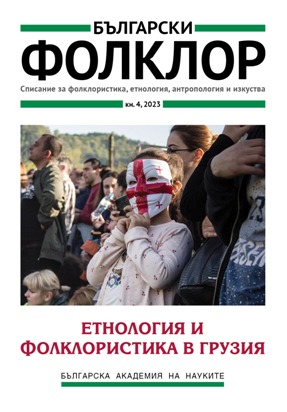Шедьовърът на Руставели – ренесансова поема или средновековен роман?
A Renaissance Narrative Poem or a Medieval Novel?
Author(s): Yordan LyutskanovSubject(s): Politics / Political Sciences, Christian Theology and Religion, Politics, History, Anthropology, Social Sciences, Language and Literature Studies, Literary Texts, Fine Arts / Performing Arts, Cultural history, Semiotics / Semiology, Customs / Folklore, Poetry, Fiction, Theoretical Linguistics, Studies of Literature, Political Theory, Governance, Sociology, Ethnohistory, History of ideas, Political history, Social history, Middle Ages, Special Historiographies:, Theology and Religion, Islam studies, Comparative Studies of Religion, Novel, Semantics, Pragmatics, Comparative Study of Literature, Politics and society, Cultural Anthropology / Ethnology, Culture and social structure , Sociology of Culture, 6th to 12th Centuries, 13th to 14th Centuries, Period(s) of Nation Building, History of Communism, Post-Communist Transformation, Eastern Orthodoxy, Other Christian Denominations, History of Islam, Inter-Ethnic Relations, EU-Accession / EU-DEvelopment, Philology, Translation Studies, Theory of Literature, Sociology of Art, Geopolitics, History of Religion, Politics of History/Memory, Politics and Identity, Identity of Collectives, Georgian literature, Psychology of Religion, Sociology of Literature
Published by: Институт за етнология и фолклористика с Етнографски музей при БАН
Keywords: Shota Rustaveli; poetics of title; poetics of translating; Soviet cultural export; national epic; chivalry romance; Renaissance; Middle Ages; Eurocentrism; anthropology of scholarship
Summary/Abstract: The article introduces to the late medieval romance in verse Vepkhistq’aosani by Shota Rustaveli – the central artefact in Georgian cultural self-awareness and the top item of ‘high’ Georgian cultural export. It briefly presents its narrative content, indicating the correlation of two plot-lines (initially through enframing, after some point though horizontal interlacing). It briefly introduces to the main fluctuations and 20th-century tendency in translating the work’s title, interpreting the fluctuations as indicative of aesthetic differences, and the tendency as an indication of the ‘cultural market’ success of the Soviet-Georgian (in its ideological and aesthetical basis –a Stalinist and socialist-realist) image of Rustaveli’s masterpiece. It presents two influential to dominant claims of Georgian Rustvelology – that the work is a poema (and not a novel/romance) and that it displays, at least partially, Renaissance outlook and poetics, – considering these claims as tools (1) of Soviet “Culture Two” to allot a proper place to Georgian nation within the alternative modernity of the USSR and its premodern background-under-construction, and (2) of Soviet-Georgian cultural nationalism to define a usable past in post-Soviet conditions; and (3) as beliefs. It revitalises the option to contextualise the work of Rustaveli (and, indirectly, Georgian cultural identity) in non-Eurocentric terms, providing some factographic and theoretic clues from the field of macrohistory (J. Abu-Lughod et al.) and a methodological one from sociology of arts (P. Bourdieu).
Journal: Български фолклор
- Issue Year: XLIX/2023
- Issue No: 4
- Page Range: 636-661
- Page Count: 26
- Language: Bulgarian
- Content File-PDF

